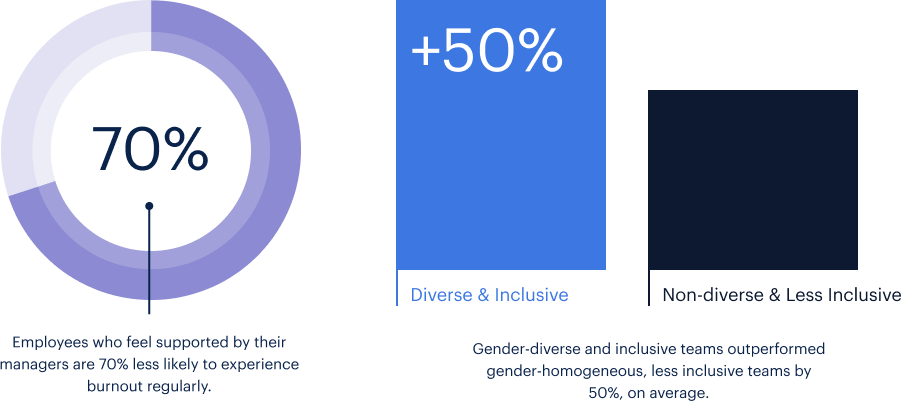
La industria tecnológica evoluciona constantemente con nuevos avances e innovaciones tecnológicas. Sin embargo, las grandes empresas tecnológicas siguen enfrentándose a obstáculos. A medida que entran nuevos competidores en el sector, aumenta la importancia de contratar y retener a los mejores talentos, y las empresas deben seguir el ritmo de una mano de obra en constante cambio. Crear soluciones sostenibles y escalables que den prioridad al bienestar y el desarrollo de los empleados es más importante que nunca.
¿Cuáles son los mayores retos de la industria tecnológica?
La industria tecnológica se enfrenta a un mercado laboral competitivo, y se necesitará estrategia y adaptabilidad para mantenerse en cabeza. Los profesionales de RRHH se están dando cuenta no solo de la necesidad de competencias básicas como la agilidad, la resiliencia y la competencia tecnológica, sino también del valor de las perspectivas diversas y de una mayor atención al bienestar, el desarrollo profesional y el compromiso de los empleados.
Reto 1 - Rotación y retención
Los altos índices de rotación y retención son críticos para los departamentos de RR.HH. del sector tecnológico. El sector está innovando y la competencia por los mejores talentos es cada vez mayor. Con 13,2%, la industria tecnológica registra el mayor índice de facturación de todos los sectores. Con la aparición de nuevas tecnologías y la incorporación de nuevas generaciones a la plantilla, los responsables de Recursos Humanos deben examinar sus estrategias de retención de forma holística.
Reto 2 - Diversidad e inclusión
La diversidad en el sector tecnológico es uno de los retos de RRHH más importantes del sector; existe una responsabilidad cada vez mayor de hacer avanzar la aguja. Aunque la mayoría de las empresas tecnológicas valoran la diversidad, el progreso hacia una plantilla más inclusiva ha sido lento. Utilicemos Facebook, por ejemplo; su plantilla ha pasado de 3% negros a 3,8% en los últimos seis años. Además, un informe de McKinsey descubrió que por cada 100 hombres ascendidos a directivos, sólo 85 mujeres eran ascendidas, y esta diferencia era aún mayor en el caso de algunas mujeres: sólo 58 negras y 71 latinas eran ascendidas.
Reto 3 - Burnout de los empleados
El agotamiento de los empleados es muy común en el entorno competitivo y acelerado de la industria tecnológica. Aunque una carga de trabajo excesiva y el exceso de horas extraordinarias son factores importantes, el agotamiento suele deberse a una mala gestión y a una cultura negativa en el lugar de trabajo. Según el Burnout Index -una encuesta realizada por Yerbo-. 2 de cada 5 profesionales de TI encuestados muestran un alto riesgo de agotamiento.
Reto 4 - Atraer y contratar a los mejores talentos
Como cualquier otro sector, el de la tecnología, a menudo sometido a fuertes presiones, ha tenido que hacer frente a numerosos retos en materia de contratación. La mano de obra actual tiene expectativas más altas que nunca y busca entornos de trabajo más centrados en el ser humano: los empleados exigen a sus empleadores algo más que un sueldo. Con una menor reserva de talento de candidatos cualificados y altas tasas de rotación, las empresas tecnológicas deben adaptarse e implementar cambios innovadores en el proceso de contratación y reclutamiento.

Soluciones de TaskHuman
Las nuevas generaciones de talentos se incorporan a la población activa y esperan otro tipo de lugar de trabajo. Un mayor enfoque en las personas permitirá que la industria de la tecnología y su fuerza de trabajo crezcan. Al aprovechar la plataforma TaskHuman, su organización puede mejorar el compromiso de los empleados, atraer y retener el talento y crear oportunidades de desarrollo.
Soluciones a la rotación y la retención:
Potenciar la cultura de aprendizaje de una organización es vital para la rotación y retención de los empleados. Con las altas tasas de rotación del sector tecnológico, RRHH debe desarrollar e implementar estrategias que mantengan a los empleados motivados, productivos y comprometidos. Proporcionar programas flexibles que apoyen el desarrollo personal y profesional es extremadamente valioso, especialmente cuando se abre el mercado de talentos a la generación más joven. Crear un entorno de trabajo positivo y de apoyo en el que los empleados se sientan valorados, respetados y capacitados a través de programas de tutoría y coaching de liderazgo.
Recursos para directivos de RRHH:
Por qué la tutoría es importante para el crecimiento de la empresa
Cómo aumentar el número de participantes en su programa de tutoría
Soluciones para la diversidad y la inclusión:
La industria tecnológica ha adolecido de una grave falta de diversidad, y los trabajadores han dejado claro que asuntos de diversidad, equidad, inclusión y pertenencia (DEIB). Los empleados son 47% más propensos a permanecer en una organización si es integradora. Con quién y para quién se trabaja es importante: los empresarios no deben subestimar esas relaciones laborales. Los departamentos de RRHH pueden apoyar y potenciar un lugar de trabajo inclusivo aplicando Programas DEIB y robustos Grupos de Recursos para Empleados (ERG). Los ERG actúan como constructores de cultura que pueden crear un sentido de comunidad e impulsar el cambio hacia un lugar de trabajo más equitativo. Los ERG pueden trabajar codo con codo con las iniciativas de DEIB y, cuando se hacen bien, permiten impulsa la cultura de la organización, aumenta el compromiso de los empleados y potencia la productividad.
Recursos para los responsables de RRHH:
La guía TaskHuman de los grupos de recursos para empleados (ERG)
Ver a la carta: Introducción a los programas de diversidad, equidad, inclusión y pertenencia (DEIB)
Soluciones al agotamiento de los empleados:
Adopte medidas para reducir el agotamiento poniendo en práctica programas flexibles de bienestar que faciliten la gestión del estrés y prácticas saludables para la vida laboral. Cree un espacio en el que los empleados puedan prosperar mejorando la cultura de la empresa. 89% de los trabajadores de empresas que apoyan iniciativas de bienestar son más propensos a recomendar su empresa como un buen lugar para trabajar.
Tan importante como es que los empresarios ofrezcan apoyo para el bienestar, los empleados también pueden recibir el apoyo que necesitan de sus jefes. Los directivos deben estar capacitados para desarrollar competencias interpersonales y aplicar estrategias de compromiso adecuadas. El compromiso genera muchos resultados positivos, como una mayor productividad, eficiencia y rentabilidad. Las estrategias de compromiso efectivas pueden consistir en reuniones individuales periódicas, comentarios y elogios constantes, objetivos tangibles y una comunicación fluida. desarrollo profesional.
Recursos para los responsables de RRHH:
Lista de comprobación de las mejores prácticas del programa de bienestar
Dirigir y triunfar en la incertidumbre
Soluciones para atraer y contratar a los mejores talentos:
Dada la competitividad del mercado laboral, las empresas tecnológicas tendrán que esforzarse al máximo a la hora de captar talentos. Además de una remuneración competitiva, cultura empresarial positiva mejorará la estrategia de contratación de una organización, atraerá y retendrá talentos altamente cualificados y promoverá cambios positivos con más innovación. No cabe duda de que una cultura positiva e innovadora es fundamental para el éxito continuado de cualquier empresa. Las organizaciones pueden conseguir esa cultura ampliar la base de contratación y centrándose en capacitar a sus empleados en su conjunto. Al ofrecer oportunidades de desarrollo, Iniciativas DEIBy promoción profesionalDe este modo, los departamentos de RR.HH. pueden atraer más fácilmente a talentos que quieran crecer y desarrollarse dentro de la empresa.
Recursos para los responsables de RRHH:
Lista de comprobación sobre diversidad, equidad, inclusión y pertenencia
Guía para desarrollar un marco de liderazgo adaptable

Crecimiento y apoyo de los empleados a escala
La plataforma TaskHuman conecta una red global de expertos profesionales con sus empleados, liberando todo su potencial, mejorando el rendimiento y el compromiso, y proporcionando apoyo preventivo al instante.
Fuentes: McKinsey, Yerbo, Gallup, Gartner
[hubspot type=cta portal=8109744 id=f6c644b4-ae9e-48c1-8264-9897e5509051]